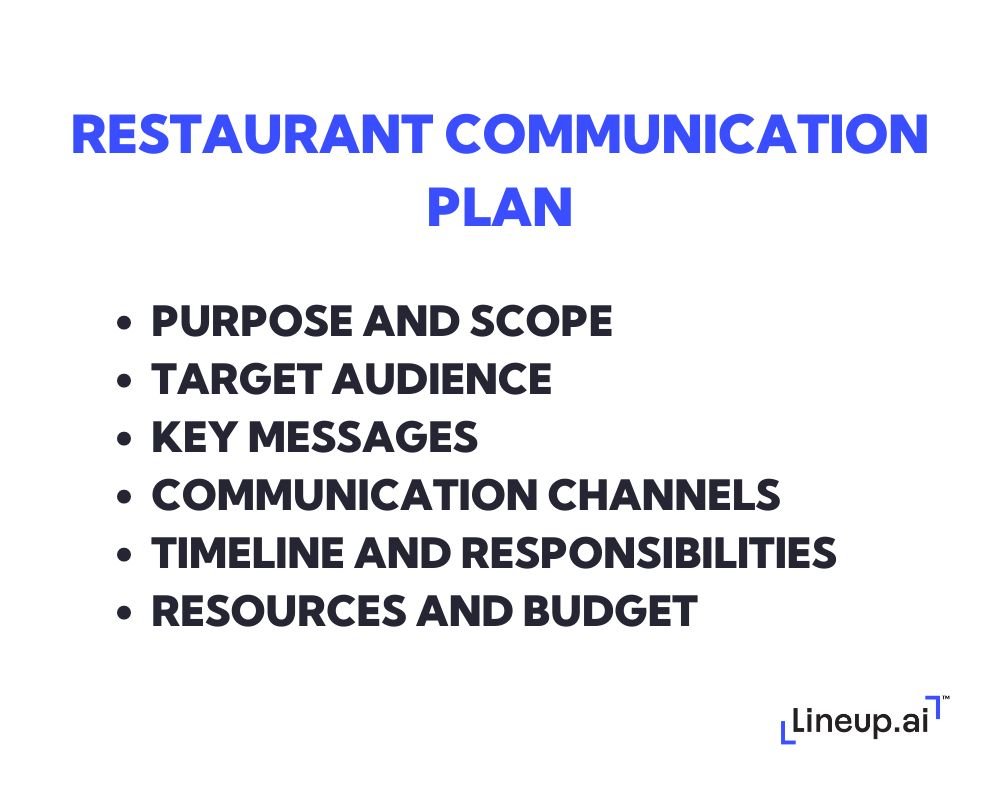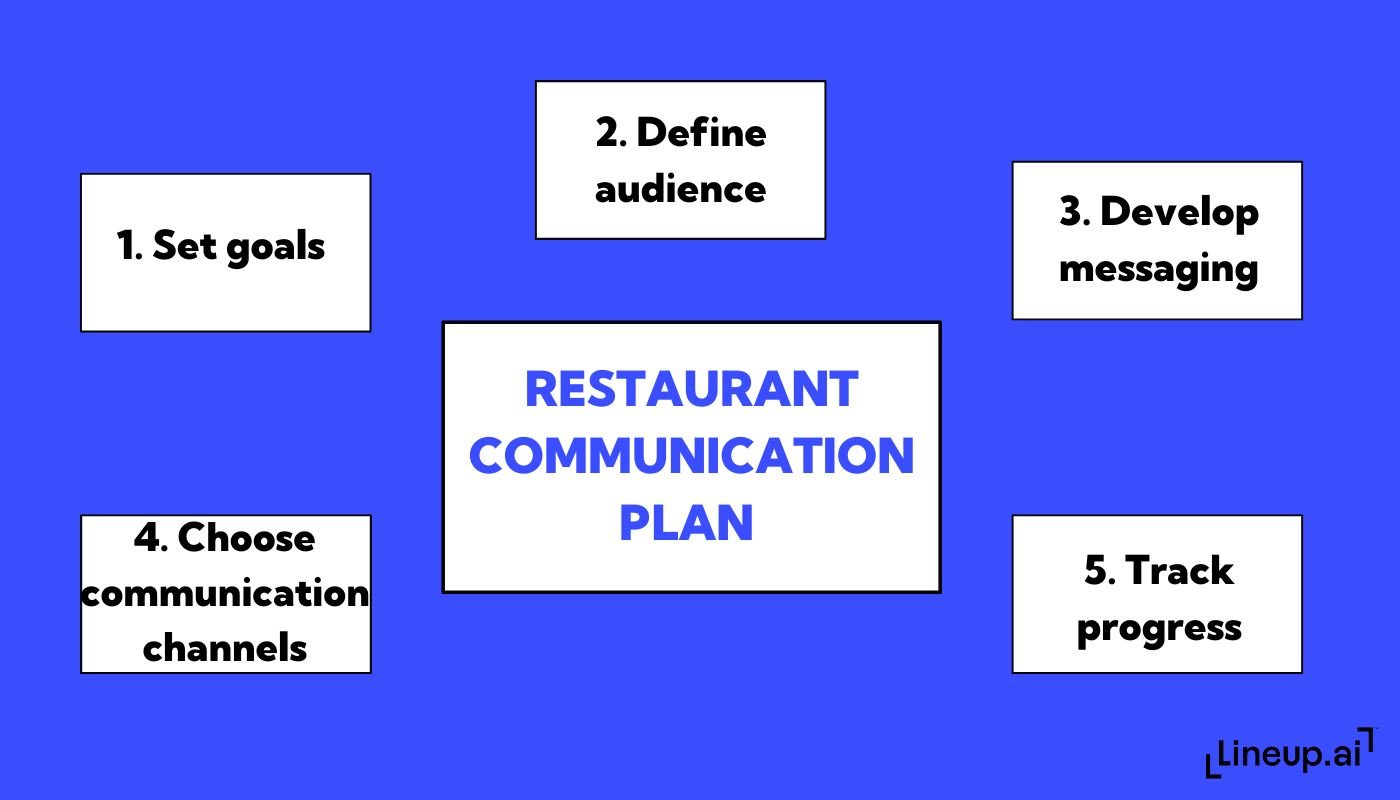Your restaurant’s brand image and reputation are heavily influenced by the way you communicate with customers. According to a Harvard Business School research, a one-star increase in a restaurant's rating on Yelp is associated with a 9% increase in profits.
A restaurant communication plan can help you solidify your messaging and allow you to stay consistent throughout all communication with customers.
In this blog post, we’ll explain all the benefits of having a restaurant customer communication plan and show you how to create one from scratch.
What is a restaurant communication plan?
A restaurant communication plan is a document that outlines a restaurant’s communication goals with its customers, employees, and stakeholders, as well as the strategies and tactics it will use to achieve them. The communication plan should be a comprehensive document that includes information on the restaurant's target audience, key messages, communication channels, timelines, and responsibilities.
A typical restaurant communication plan contains several sections.
The first section outlines the purpose and scope of the plan, including the goals and objectives that the restaurant wants to achieve through its communication efforts.
The second section identifies the restaurant's target audience and describes their needs, preferences, and communication habits. This information helps the restaurant tailor its messages and communication channels to effectively reach and engage its audience.
The third section of the plan describes the key messages that the restaurant wants to communicate. These messages should be clear, concise, and aligned with the restaurant's brand values and mission.
The fourth section outlines the communication channels that the restaurant will use to reach its target audience, such as social media, email, SMS, or in-person communication.
The fifth section of the plan includes a timeline that specifies when each communication activity will take place and who is responsible for carrying it out. This helps the restaurant stay organized and ensures that everyone is on the same page. The final section of the plan outlines the resources and budget required to implement the communication plan successfully.
To give you an example, here's a simple template for a restaurant communication plan:
- Purpose and scope
- Target audience
- Key messages
- Communication channels
- Timeline and responsibilities
- Resources and budget

Why you need a restaurant communication plan
Creating a restaurant communication plan allows you to:
- Achieve clarity on how you should communicate – A restaurant communication plan will help guide all your restaurant’s communication efforts, from making public announcements to sharing updates on social media.
- Keep your messaging consistent – Outlining your brand’s tone, voice, and values in a communication plan will enable you to keep your messaging consistent and help you deliver a cohesive message.
- Stay prepared for a PR crisis – With enough time, most brands will experience a PR crisis of some sort. These types of crises are detrimental to all types of businesses, but can be especially disastrous for those in the restaurant industry. A communication plan will help your team members stay prepared for dealing with a crisis once it happens.
5 steps to creating a restaurant communication plan
If you got this far, you already know what a restaurant communication plan is and why you need it. In this section, we’ll go over the five steps you need to take to create an effective communication plan for your restaurant.

1. Set goals
The first step to creating a restaurant communication plan involves setting goals. Think about what you’d like to accomplish with your restaurant’s communication efforts.
Some common goals for restaurants include:
- Improving brand awareness
- Establishing brand positioning
- Increasing online orders
- Driving repeat visits
When setting goals, you’ll want to make sure that they’re SMART:
- Specific – Any goal you set should be specific. In other words, it should be clear what needs to be accomplished and who’s responsible for doing it.
- Measurable – Goals also need to be measurable so that you can track progress and know when they’ve been achieved.
- Achievable – It’s important to be realistic when setting goals. Any goal you decide on should be achievable by your team in a reasonable timeframe.
- Relevant – Goals also need to be relevant to the overall vision you have for your restaurant. They should not be based on vanity metrics, but rather have a direct impact on the business’ bottom line.
- Time-bound – You need to set a deadline for when your goal should be achieved. This will help your team stay on track when working towards achieving the goal.
Here’s an example of a SMART goal:
We will increase the number of monthly online orders generated through the restaurant’s website by 30% in the next 12 months.
2. Define your audience
Once you’ve outlined goals for your communication plan, you need to define the audience you’re looking to reach.
Think about who you want to communicate your restaurant’s message to. Who are these people, and what are their preferences, likes, and dislikes?
How do your ideal customers prefer to be communicated to? What’s important to them?
Answering these questions will help you:
- Determine which communication channels you’ll use
- Decide on the best types of promotions
- Refine your message for improved results
Note that you don’t have to answer these questions on your own — your customers can help you.
Consider performing surveys or interviewing your existing customers to learn more about them and create customer personas you can use to guide your restaurant communication strategy.
3. Develop your messaging
Developing your messaging is the most important step in creating a restaurant communication plan. Here, you’ll want to clarify the following:
- Your restaurant’s values and mission statement — What your restaurant stands for, what’s your attitude towards serving guests, and how you treat employees.
- What your customers should know about your restaurant – Are you a pet-friendly, family-oriented, or vegan restaurant? List everything customers should know about your restaurant.
- The voice, tone, and language that will resonate with your audience – You should make it clear what kind of voice, tone, and language should be used when communicating with customers.
These three things should stay consistent throughout your restaurant’s communication.
4. Decide on communication channels
Your communication plan will inevitably include the channels you’re going to use to communicate with your audience.
A good starting point for deciding on communication channels will be the target audience research you performed in one of the previous steps. In general, you’ll want to be everywhere your audience spends time.
Note that you should also test out other channels to see if they can generate results for you. Some common ones include:
- Website and blog – Your website serves to introduce people to your brand, while your blog can be useful for sharing news and announcements. These two channels will often form the basis of a restaurant’s digital communication.
- Email list – An email list can help you notify your audience of new offers and promotions, boosting your overall restaurant marketing efforts.
- Social media – Restaurants often use their social media pages to build a community of loyal customers and keep their brands top of mind at all times with regular social media posts.
- Print, radio, and TV ads – Traditional media ads are useful for improving brand awareness and getting more people to learn about your restaurant’s offering.

5. Track progress
You need a way to track progress and evaluate whether your communication strategy is working.
The best way to do this is to assign one or more metrics to each goal you set for your communication plan.
For example, if one of your goals is to improve brand awareness, you could use metrics such as the number of branded searches or social media mentions to track progress.
Once you decide on metrics you’re going to use to track progress, determine a schedule for reviewing performance (e.g., weekly or monthly) and stick to it.
Keep your communication on track with a restaurant communication plan
Providing a great customer experience in a restaurant is a necessity for building a successful business. How you communicate with customers is a big part of that experience.
Follow the steps outlined above to create a restaurant communication plan that will ensure your restaurant’s communication stays consistent and on-brand at all times.
While you’re here, check out these restaurant management guides:

Boris Mustapic is a content marketer with a decade of experience in the digital marketing industry. He specializes in helping B2B SaaS companies drive growth through strategic, product-led content marketing.
More about the author